Welcome to the definitive guide on “How to choose a wheelchair for the elderly?”. We will help you every step of the way, simplify technical terms, and give you an exhaustive set of considerations to look at so that you are able to choose the best wheelchair suited for your loved ones.
Contents
If you or your loved one has recently been recommended moving about using a wheelchair, do not worry. A mobility aid like a wheelchair opens up the world for those who would otherwise be confined to their bed or home. But the first question that needs to be answered really is, how do you choose a wheelchair?
We will answer all your wheelchair-related questions in this article.
Nearly 50 million American’s are above the age of 65. Estimates suggest that by 2050, nearly one in five people in North America will be above this age. Among the elderly, nearly forty percent face at least one disability, and two out of three among those forty percent find it difficult to walk or climb stairs.
If you have never thought about disability among the elderly, I hope these numbers would have woken you up to the magnitude of the situation.
But to anybody who is facing disability or whose loved ones are in the grips of this issue, these are not just statistics. You cannot measure the very real impact upon your life in bland numbers and drab research studies.

Mobility aids like wheelchairs, walkers, rollators, mobility scooters, canes, prosthetic devices, crutches, and even orthotics help regain a semblance of normalcy in your life. Giving your loved ones the freedom to move helps them complete daily tasks, instills confidence, and gives them back their dignity.
Wheelchairs: An Overview
Wheelchairs have been around for over four centuries. They are the most popular mobility devices by far, with nearly 1mn elderly users in the US alone. While traditionally, manual wheelchairs are more common, electric or power wheelchairs’ popularity is growing at a quicker pace in recent years.
Given that everyone is unique, over the last four hundred years, wheelchairs have been adapted to suit many unique uses. Now, you can take them with you on a plane or to the beach or even to the trail that you have been wanting to go to.
If you have done some research to buy a wheelchair for your loved ones, you might have found yourself perplexed by the options, technical terms, and jargon online. Let us try to work our way through the myriad wheelchair options and wheelchair accessories available today.
What To Do Before You Choose a Wheelchair
Is a Wheelchair Right For You?
Before you start searching for a wheelchair, the first thing to do is to examine whether a wheelchair is the best option. Mobility aids come in many varieties, each useful for a specific purpose.
Start by getting a full evaluation done by a physical therapist. They are experts who can evaluate the extent of your mobility impairment and suggest the right alternative.
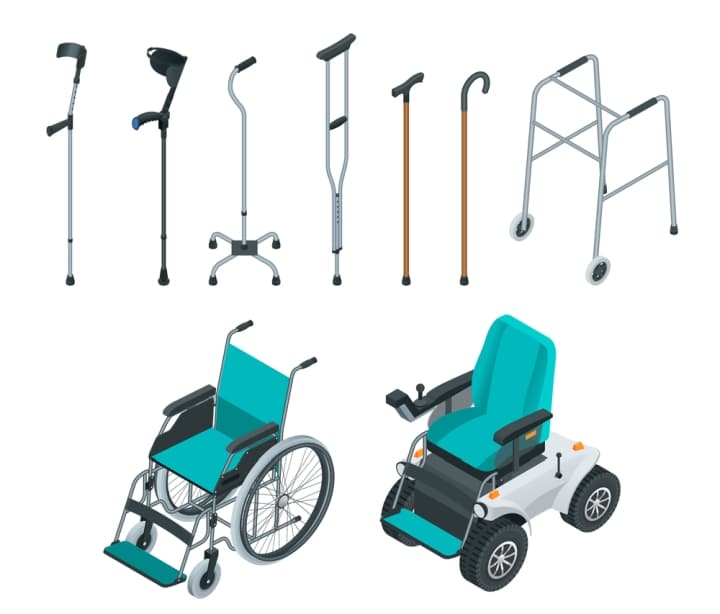
As a thumb rule, you should only choose a wheelchair if your mobility is severely impaired and you are unable to walk at all, even with support for any practical distance.
If your mobility is limited only to one leg, you should opt for a cane or a crutch. If you can walk but need a bit of support, a rollator or a walker might be a good option for you.
If your only concern is that you cannot walk long distances, then a mobility scooter may also be a very good option.
Questions To Ask Yourself Before Getting a Wheelchair
Once you are sure that a wheelchair is the best option for you, ask yourself some of these questions and carefully note their answers. We will discuss some of these questions when we get to the “Types of Wheelchairs” sections below.
- Do you have a caregiver who can assist you with your wheelchair? Or do you have the strength to be able to propel your wheelchair yourself?
- Where will you use the wheelchair? Only in the house, only for going outside, or both?
- How dependent are you on the wheelchair? Will you use it throughout the day, or only occasionally?
- How much space do you have to keep your wheelchair in the house?
- How often do you need to travel outside, especially on long trips and flights?
- Are your doorways and corridors large enough to accommodate a wheelchair?
- What kind of home modifications will you need? (a result of the previous question)
- Will your insurance or Medicare cover the costs of a wheelchair?
- What is the price range that you can afford, in case insurance does not cover things?
- Do you have any special needs, such as sensitivity to pressure sores, backaches, arthritis, neck pain, or other problems that can become aggravated by sitting for a long time?

This list is not exhaustive, but it certainly covers the most important aspects. Answering these questions will prepare you for some tough decisions that you might have to take ahead.
Taking Measurements
If you use your wheelchair regularly, you must sit comfortably on it. For this, you need to understand your measurements and choose a wheelchair accordingly.
You should note down the below measurements carefully so that you can compare them with any wheelchair you purchase:
- Seat the user in a normal chair, with their back aligned with the chair’s backrest and feet resting comfortably on the ground
- Measure the height of the legs from the ankle to the knee. The distance between your wheelchair’s footrest to the seat should be this much.
- Measure the length of the leg from the knee to the hip. This distance should be the depth of your wheelchair’s seat. While slightly deeper will do, it should in no circumstances be less deep than this measurement.
- Measure the distance between the hips, and add 2 inches on either side to it. Your wheelchair seat should be at least this wide.
- Measure the user’s torso up to the neck and the neck to the head. Your wheelchair seat should have a similar height and headrest height for a comfortable seating position.
- Measure the length of the arm from the shoulders to the elbows and the elbows to the seat. Your wheelchair’s armrests must be in this position.
- Measure the weight of the user. Your wheelchair should ideally be rated to hold at least 50 pounds higher than this weight.
- Lastly, note the size and length of the feet. The footrests should be large enough to hold them. If the person would need to recline, calf support is also a must.
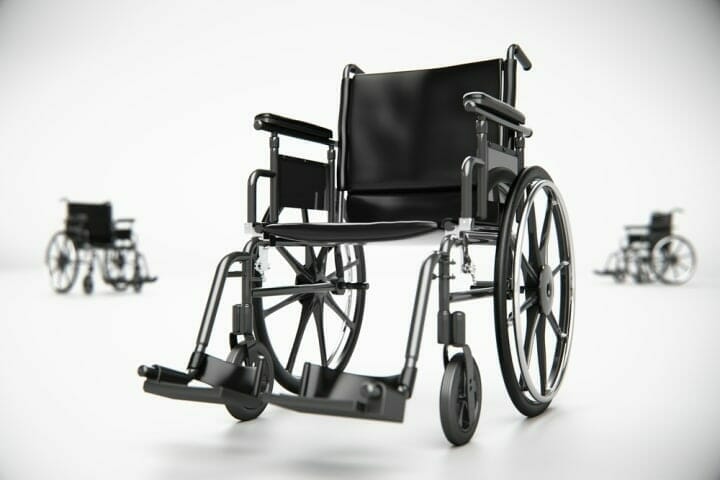
Remember, even though you may get a wheelchair with perfect measurements, it may not fit the user over time. Our bodies change; sometimes we put on weight, and sometimes we lose it.
It is important to select a flexible wheelchair that can accommodate such changes in body size and shape.
Selecting the Right Wheelchair for the Elderly
Now that you have done the necessary pre-work, it is time to dive into the actual wheelchair selection. There is no standard way to select a wheelchair, but we have tried to put a method so that you are able to choose the wheelchair most suited to your needs.
Are You Able To Push Your Wheelchair?
This question is perhaps the most important one to address as you set out to buy a wheelchair. The answer to this question will decide whether you can do with a manual wheelchair or you need an electric wheelchair.
If you cannot propel yourself forward or can only do it for a limited amount of time because of low upper body strength, it would be best for you to opt for a power wheelchair.
On the other hand, if you can propel your wheelchair or have a caregiver who lives full time with you, it would be good to use a manual wheelchair instead. By using self-propelled wheelchairs, you will be able to keep your upper body fit.
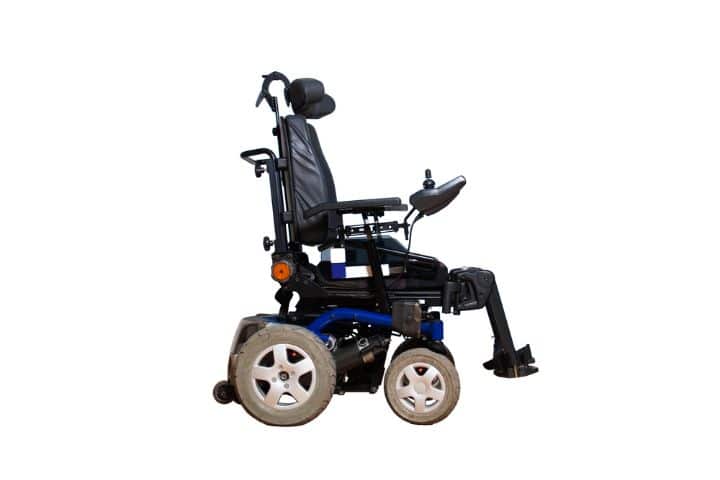
If you need to use the wheelchair for a significant part of the day but don’t have the strength to move it yourself, you should consider using a power wheelchair for outdoor use.
Choosing a power wheelchair requires a bit of research. You need to decide which design (front, mid or rear-wheel drive) you should purchase. You also need to understand which type of controls (joystick or microswitches) might be good for you. Then there are technical details like the battery type and size, motor power, and what type of tires you may need.
Suppose you prefer the simplicity of a manual wheelchair but crave the convenience of a power wheelchair for short trips around the house and other activities. In that case, you can also add a motor/bike attachment to your manual chair.
A motor/bike attachment helps to convert a manual wheelchair into a motor-operated bike! Try to find one that has a good battery and a strong motor, and is compatible with the wheelchair.
How Much Do You Use the Wheelchair?
Depending on your disability, you may be using a wheelchair almost the entire day, or you might just be using it occasionally for groceries and short trips outside.
If you are using a wheelchair for the better part of the day, you should look for the most comfortable wheelchairs. Wheelchairs with adjustable height, armrests and footrests as well as comfortable and cushioned seating will be the ideal choice.
An important feature to look for in the wheelchair will be its ability to recline. A headrest in a wheelchair provides much-needed support for your shoulder and neck in the form of a headrest.
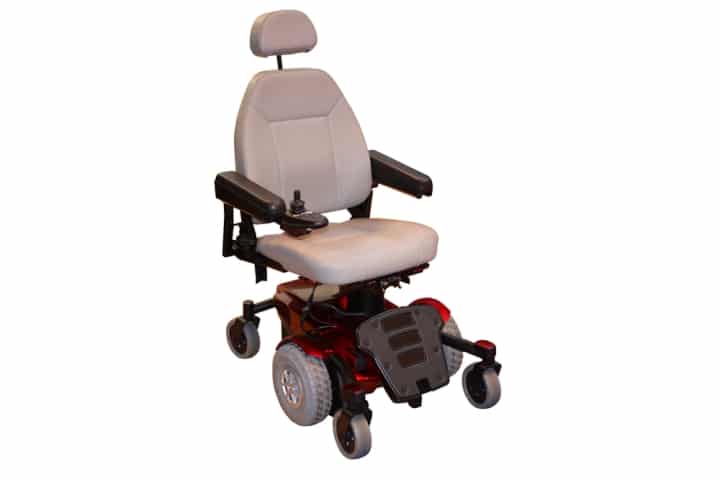
Sometimes the user is confined to their bed and cannot even reach the bathroom. For such cases, there is an option for a wheelchair with a commode. The commode is removable and washable for hygiene.
Wheelchair Accessories
Apart from wheelchair design, you can also consider adding a lot of great accessories to your wheelchair. They will make it more comfortable to use your wheelchair for extended periods of time.
For long-term wheelchair users, wheelchair cushions can help with sciatic pain or pressure sores. These cushions are designed from memory foam, which takes on the shape of the user’s back-side and provides the right support and breathability to ensure that you are neither plagued with skin problems nor do you have to suffer from bad posture.
Another accessory that can make things comfortable for you is a wheelchair headrest. Wheelchair headrests provide excellent support for the shoulder and neck. Many of them are curved along with the natural curvature of your spine, ensuring the perfect posture for your body to support your head.
Wheelchair seat covers are often very useful if you are facing skin-related problems. Seat covers let you choose an alternative to the usual leather or faux-leather material of wheelchair cushions. Many times, the wheelchair may not even have too much cushioning. With the right seat cover, you will have breathable, comfortable, and machine washable support for your wheelchair seat.
Armrest covers give your hands protection from cold during the winter and heat during the summers. They also give support to your hands, if you have weakness in the hand muscles.
Do You Mostly Use Your Wheelchair Indoors?
Using a wheelchair indoors is not as simple as you may think. You need to keep in mind your total wheelchair width. It will be best to measure the narrowest passage that you must cross. Now add at least two inches to that for comfortable clearance. The maximum width of your wheelchair should not exceed that.
Thankfully, there are many narrow-width wheelchairs to do the job. However, simply having a narrow wheelchair is not enough. You would have to consider many things – for example, how to get a wheelchair upstairs and how to get the wheelchair to move across small differences in height.
For the latter, you might need to install wheelchair ramps inside your home as well.
There are ADA guidelines concerning wheelchair ramp width and height that should be adhered to when installing a permanent wheelchair ramp at home.
If you are in a manual wheelchair, it is a good idea to give some thought to the technique to push yourself up a wheelchair ramp.

Apart from ensuring that the wheelchair can move around the house comfortably, you would also need to make sure that the furniture you buy is wheelchair compatible. Similarly, it is important to have the right carpets and area rugs that work well with a wheelchair. Some high pile rugs might not be the best for many manual wheelchairs.
Lastly, it would be prudent to ensure that all your kitchen appliances such as microwaves, refrigerators, and dishwashers are aligned with ADA compliance rules to ensure that the wheelchair user can move around the house freely. You should also make sure that your toilet is ADA compliant.
You can read our detailed guide on how to make a home and business more wheelchair accessible. If you are looking at working on specific sections of your house, our guides on kitchen alterations and bathroom modifications should help.
Do You Have Special Height/Weight Needs?
Average wheelchairs support anywhere between 200 to 300 pounds of weight. But sometimes, this may not be enough to support your loved ones.
If the wheelchair user is above this weight limit, we suggest looking out for special bariatric manual wheelchairs and bariatric power wheelchairs. Bariatric wheelchairs are made of reinforced steel and even carbon fiber, and they have much wider and deeper seats than normal wheelchairs.
There are wheelchair options for both tall and short wheelchair users.
You can look at power wheelchairs with elevating seats for tall people or those who cannot bend down to get onto the wheelchair. Make sure that along with the seat you are able to adjust your wheelchair’s armrests to make it more comfortable to sit in.
There aren’t many “short” wheelchairs per se, you can look at pediatric wheelchairs as a viable option for shorter users. These wheelchairs have smaller seats, are lighter, and quite comfortable for people who are below five feet in height.
How Much Do You Travel With Your Wheelchair?
You may think that wheelchair users would find it difficult to travel a lot, but you would be wrong. Many wheelchair users make frequent trips not just to local stores and outlets but even large and overseas journeys by flight and car.
These are but a few of the growing number of tourist destinations that are wheelchair-friendly. Many magnificent cities in Europe such as Vienna, Barcelona, and Amsterdam are all wheelchair-friendly places. The casino capital of the world, Las Vegas is also wheelchair-accessible.
Similarly, an increasing number of airlines welcome wheelchair users and have special accommodations for them.
And why not? With a power wheelchair designed for outdoor use, you can experience the sights and sounds of these lovely places. If instead, you would like to use a manual wheelchair for travel, there are many options available for that too. But you might need to be accompanied by an attendant lest your arms get tired pushing the wheelchair around.
What Activities Do You Want to Do With the Wheelchair?
Wheelchair users are not just traveling by air but are also frequenting beaches. Special beach wheelchairs with wide balloon wheels that can easily navigate sand and water are helping such adventure-loving wheelchair users.
Just because you are in a wheelchair, does not mean that you can not take a religious pilgrimage like the Hajj. Hajj has many rules, restrictions, and a lot of rigor. So if you plan to go to Hajj with your wheelchair, you need to make sure that it is extremely comfortable, has a long battery life that can work for several hours at a stretch.
From gardening to playing basketball, there are many activities that wheelchair users can take up, and wheelchair technology is constantly updated to meet new requirements.

Wheelchairs for Special Needs and Situations
Not all wheelchair users are equal. So far, we have mostly talked about the wheelchair needs of the elderly with the assumption that old age is the only reason for wheelchair use. However, there are many other reasons why someone might want to use a wheelchair.
People suffering from scoliosis commonly need a wheelchair. An ergonomic wheelchair helps support the spine better for scoliosis patients.
Similarly, arthritis sufferers have constant joint pain. Wheelchairs designed for rheumatoid arthritis patients are mostly electric and easy on the joints.
There are special wheelchairs designed for patients suffering from a stroke. They provide extra cushioning and have the appropriate head, neck, and leg support, sometimes with head and leg straps.
Those who have had an unfortunate accident and are suffering from a broken leg can also find specific wheelchair options for their needs. There are even wheelchairs designed specifically for quadriplegics to help them move about as efficiently as possible.
Choosing Your Wheelchair According to the Weather
While this is not a deciding criterion for wheelchairs, do know that power wheelchairs are often susceptible to rainwater. This water-phobia is because they run on batteries which can go dead when exposed to rain.

If you live in a place where rain is very common, you should consider purchasing a rain cover or an umbrella suited for wheelchair use. If you live in cold climates, wheelchair users will need winter gloves. If you live in a hot place, you might like to consider wheelchair cooling pads and cushions.
Do You Love a Bit of Style?
A wheelchair is often viewed as a symbol of disability, but I like to look at it the other way around. A wheelchair represents freedom from disability and the need to depend on others for performing everyday tasks.
And just like you, your symbol of freedom should be as unique and as stylish as yourself. There are quite a few cool and colorful wheelchair options out there in the market, so if you are looking for a bit of panache for your wheels, there is no shortage of options for you.
Who Will Pay For the Wheelchair? And How Much?
Wheelchairs can be quite expensive. Power wheelchairs can easily set you back by a couple of thousand dollars, if not more. So this question is obviously justified. In most cases, if your doctor has prescribed a wheelchair for you, Medicare and even private insurers will cover the cost (after a small deductible).
This is why most people prefer to get a wheelchair that costs around the maximum limit their insurance covers. Do remember that for Medicare, you need to buy from registered suppliers only.
It might also be possible to get a used wheelchair for cheap, or even get a wheelchair for free, in case insurance does not work out!
But you should watch out for things like whether you can get insurance coverage, what kind of special needs you have, what type of wheelchair you need, what is the condition of the wheelchair that you are looking at (how much repair will it require?) and what all sources you can approach for the wheelchair.
Wheelchair Accessories for the Elderly
While we have briefly touched upon the subject above, there are many cool and trendy accessories for wheelchairs that can help make life comfortable for the elderly. When purchasing a wheelchair, you may also want to consider buying these:
Bags
Wheelchairs bring freedom from dependence on others. But that freedom is not of much use if you can’t carry anything in your wheelchair with you! Thankfully, wheelchair bags are available in different shapes and sizes to help you carry anything – from wallets to groceries and keychains to kitchen utensils.
Keep in mind that the bags should be easy to access while using the wheelchair. They should be machine washable and have several compartments to carry your items. It would be best if they are made of waterproof materials and are not very heavy. Some of these bags also have useful features such as reflective strips to add to the visibility of the wheelchair during nighttime.
Seat Cushions
Having to sit in a wheelchair all day is a major risk of creating pressure sores and backache. A comfortable and ergonomically designed seat cushion will help your loved ones be seated without worrying about skin problems or joint and muscle pain.
These cushions should ideally be made from memory foam or high-density foam with cooling gel for giving you comfortable support. You might also need to consider some of your loved ones’ special needs (such as in the case of hip pain, you should choose a saddle seat cushion). You may also need positioning aids for amputees.
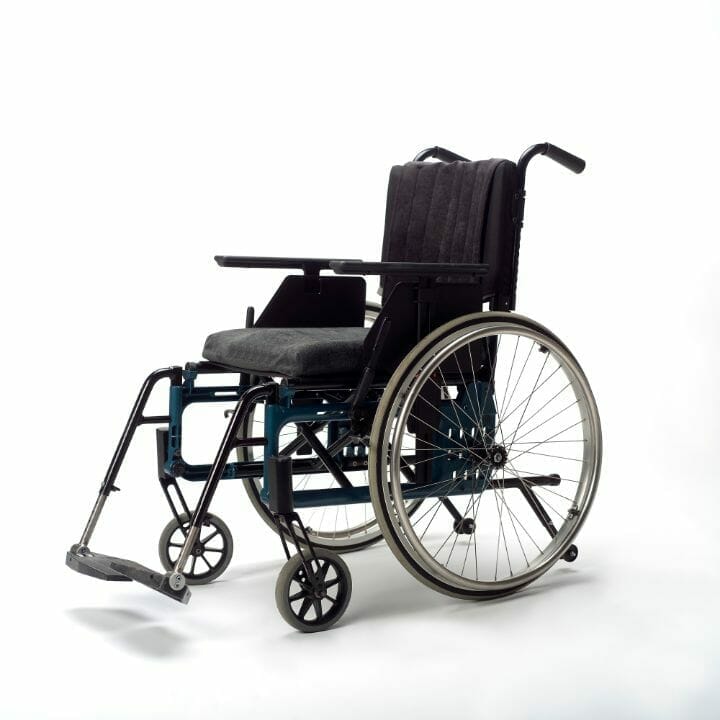
Safety
It is important for the elderly to feel safe while sitting in their wheelchair. They should be securely fastened with a wheelchair seatbelt so that there is no fall risk. While seatbelts are a basic feature present in power wheelchairs, some manual wheelchairs may not have them. Even if your loved ones use a manual wheelchair, a seatbelt is a must for regular usage.
Accessories for Power Wheelchair
Due to the electric battery and motor assembly used to run a power wheelchair, there are a few accessories that you should carry around with you if something goes wrong.
You should always have a set of spare electric wheelchair batteries with you and a rain cover to protect your power wheelchair from rain. Keep in mind that the battery should be lightweight, easy to install, hold charge for a long time (Li-ion batteries are considered the best in this regard), and have a long warranty.
Sometimes your battery may die on you suddenly; in such cases, you should know how to charge them. A pulse charger can help you to get your dead battery going in an emergency, though it may not work in case your battery is discharged too much.
Fitness Monitors for Wheelchair Users
Elderly wheelchair users should be extra careful about their fitness; walking is no longer an option for them. There are some great fitness watches for wheelchair users that will give you information on the calories burnt and activity level achieved when you use a wheelchair.
Keep in mind, though, that when buying a fitness monitor for a wheelchair user, the watch should have a “disability mode” or “wheelchair mode” option. Secondly, these monitors work correctly only with self-propelled wheelchairs, not power wheelchairs.
Tire Pump
While not as common, wheelchairs can also get punctured tires. And when you are in a wheelchair, it can be frustrating to get a tire burst or puncture. That is why it is important to carry a wheelchair tire pump with you at all times.
Please ensure that the pump that you buy should be compatible with the valve of the wheelchair tires, and it should have a pressure gauge so that you can monitor the tire pressure at all times. You should also learn about installing wheelchair tires if you need to put in a new one.
Other Accessories/Features
The list of features and accessories that we have shared here is not exhaustive by any means. Wheelchairs have been around for ages, and a lot of innovation has already happened around user comfort. Some features that you might want to look out for in your wheelchair:
- Adjustable armrests: It is very important to have armrests whose height can be adjusted to accommodate your loved ones’ hands properly. Remember the 90-90-90 rule: The elbow, hips, and knees should all be bent at a 90-degree angle for the most comfortable position.
- Elevating leg rests: This is a great way to promote the correct blood flow and improve circulation in the body. When combined with a reclining backrest and elevating leg rest can put the user in a zero-gravity position, giving them a very comfortable and weightless feeling.

- Fully reclining backrest: A fully reclining backrest is more important for the caregiver than the wheelchair user. By pulling back the seat, the caregiver can easily examine your skin for lesions and pressure sores and perform some transfers.
- Lockable brakes: Wheelchairs, just like any other vehicle, need brakes. You might wonder why, but imagine having to roll a wheelchair over a bump on the road or an incline. Without a lockable brake, you will just roll right down without stopping, which can be a huge hazard to your safety.
- Anti-tip: Another very important safety feature is anti-tip. These low-cost gadgets can help save a lot of pain and suffering in the form of fall injuries.
Wrap Up
We hope we could clarify any of your doubts, questions, and queries about choosing a wheelchair for the elderly. Remember that in choosing a wheelchair, preparation is very important in everything else in life.
Getting to know and understand your loved one’s needs will go a long way in making the right choice. Do sit down and answer many of the questions that we have written about in this article; they will help you narrow down your search and make an informed choice.
We hope we have been able to answer all your questions on how to choose a wheelchair for the elderly. As always, please leave us your questions, comments, and suggestions to improve the quality of our articles.

